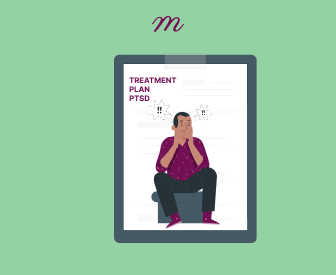This guide is designed to assist mental health practitioners in creating comprehensive, evidence-based treatment plans for clients struggling with PTSD. We’ll explore the intricacies of PTSD diagnosis, outline key components of a robust treatment plan, and provide real-world case studies to illustrate practical applications.
PTSD is a complex disorder that can significantly impact an individual’s quality of life. As mental health professionals, our role is crucial in helping clients process traumatic experiences and develop effective coping strategies. This guide aims to enhance your existing knowledge and provide fresh insights into creating tailored treatment plans for PTSD.
We’ll cover the following key areas:
- Understanding PTSD: Clinical Presentation and Differential Diagnosis
- DSM-5 Classification and Diagnostic Criteria
- Components of a Comprehensive PTSD Treatment Plan
- Evidence-Based Treatment Modalities for PTSD
- Pharmacological Interventions in PTSD Treatment
- Case Studies and Sample Treatment Plans
Let’s get into each section to deepen our understanding and improve our clinical practice in treating PTSD.
Understanding PTSD: Clinical Presentation and Differential Diagnosis
PTSD is a trauma and stressor-related disorder that can develop after exposure to a traumatic event.
Key features include:
- Re-experiencing symptoms (e.g., flashbacks, nightmares)
- Avoidance of trauma-related stimuli
- Negative alterations in cognition and mood
- Hyperarousal symptoms
Differential Diagnosis:
It’s essential to consider other conditions that may present with similar symptoms:
- Acute Stress Disorder
- Adjustment Disorders
- Anxiety Disorders (e.g., Panic Disorder, Generalized Anxiety Disorder)
- Depressive Disorders
- Dissociative Disorders
- Substance Use Disorders
DSM-5 Classification and Diagnostic Criteria for PTSD Treatment Planning
The DSM-5 outlines specific criteria for diagnosing PTSD. These include:
Criterion A: Exposure to actual or threatened death, serious injury, or sexual violence
Criterion B: Presence of intrusion symptoms
Criterion C: Persistent avoidance of stimuli associated with the traumatic event(s)
Criterion D: Negative alterations in cognitions and mood associated with the traumatic event(s)
Criterion E: Marked alterations in arousal and reactivity associated with the traumatic event(s)
Criterion F: Duration of the disturbance is more than one month
Criterion G: The disturbance causes clinically significant distress or impairment in functioning
Criterion H: The disturbance is not attributable to the physiological effects of a substance or another medical condition
Components of a Comprehensive PTSD Treatment Plan
A well-structured PTSD treatment plan should include:
a) Problem Statement: Clear description of the presenting issues and traumatic experience(s)
b) Goals: SMART (Specific, Measurable, Achievable, Relevant, Time-bound) treatment goals
c) Objectives: Concrete steps to achieve each goal
d) Interventions: Specific therapeutic techniques and strategies
e) Evaluation Criteria: Methods to assess progress
f) Timeline: Estimated duration and frequency of treatment
g) Safety Planning: Strategies to manage potential crises or suicidal ideation
h) Collaboration: Involvement of other healthcare providers or support systems
Evidence-Based Treatment Modalities for PTSD
Several evidence-based approaches have shown effectiveness in treating PTSD:
- Cognitive Processing Therapy (CPT)
- Prolonged Exposure Therapy (PE)
- Eye Movement Desensitization and Reprocessing (EMDR)
- Cognitive Behavioral Therapy (CBT) with a trauma focus
- Narrative Exposure Therapy (NET)
- Skills Training in Affective and Interpersonal Regulation (STAIR)
- Acceptance and Commitment Therapy (ACT) for PTSD
Pharmacological Interventions in PTSD Treatment
While psychotherapy is the first-line treatment for PTSD, medication can be a helpful adjunct. Common pharmacological interventions include:
- Selective Serotonin Reuptake Inhibitors (SSRIs): e.g., sertraline, paroxetine
- Serotonin-Norepinephrine Reuptake Inhibitors (SNRIs): e.g., venlafaxine
- Prazosin (for PTSD-related nightmares)
- Mood stabilizers or atypical antipsychotics (in some cases)
Case Studies and Sample PTSD Treatment Plans
Let’s examine three case studies with corresponding treatment plans:
Case Study 1: John, 35-year-old male combat veteran
John, a 35-year-old Marine Corps veteran, sought treatment for PTSD symptoms following two tours in Afghanistan. He reported frequent nightmares about combat experiences, hypervigilance in public spaces, and emotional numbing. John described avoiding crowded places and struggling to connect emotionally with his wife and children. He also reported increased alcohol use to help manage anxiety and sleep difficulties.
Upon assessment, John met full criteria for PTSD according to DSM-5. His PCL-5 (PTSD Checklist for DSM-5) score was 58, indicating severe PTSD symptoms.
The assessment also revealed comorbid depression and alcohol use disorder.
Treatment Plan for John:
Goal 1:
Reduce PTSD symptoms as measured by a decrease in PCL-5 score from 58 to 30 or less within 16 weeks.
Objectives:
- Engage in weekly Prolonged Exposure (PE) therapy sessions
- Complete between-session exposure exercises as assigned
- Practice relaxation techniques daily
Interventions:
- Provide psychoeducation about PTSD and its treatment
- Implement Prolonged Exposure protocol, including in vivo and imaginal exposure
- Teach and practice breathing retraining and progressive muscle relaxation
Goal 2:
Decrease alcohol consumption to no more than 7 standard drinks per week within 12 weeks.
Objectives:
- Attend weekly individual therapy sessions addressing alcohol use
- Maintain a daily drink log
- Identify and practice at least three alternative coping strategies
Interventions:
- Utilize motivational interviewing techniques to enhance motivation for change
- Implement cognitive-behavioral strategies for managing alcohol cravings
- Provide psychoeducation on the relationship between PTSD and substance use
Goal 3:
Improve family relationships as evidenced by increased emotional engagement and communication within 20 weeks.
Objectives:
- Attend bi-weekly couples therapy sessions with spouse
- Practice emotion regulation skills daily
- Engage in at least one family activity per week
Interventions:
- Implement Skills Training in Affective and Interpersonal Regulation (STAIR)
- Provide psychoeducation to family members about PTSD
- Teach and practice effective communication skills in couples sessions
Evaluation:
- Weekly administration of PCL-5
- Bi-weekly assessment of alcohol consumption
- Monthly feedback from family members on relationship quality
Medication:
Start sertraline 50mg daily, titrating up to 200mg as tolerated. Consider adding prazosin for nightmares if needed. (hypothetical)
Case Study 2: Sarah, 28-year-old female sexual assault survivor
Sarah, a 28-year-old teacher, sought treatment for PTSD symptoms following a sexual assault that occurred one year ago. She reported intrusive memories of the assault, severe anxiety in social situations, and difficulty maintaining intimate relationships. Sarah described feeling constantly on edge, struggling with concentration at work, and experiencing frequent panic attacks.
Assessment revealed that Sarah met full criteria for PTSD and Panic Disorder. Her PCL-5 score was 52, indicating severe PTSD symptoms. She also reported symptoms of depression and low self-esteem.
Treatment Plan for Sarah:
Goal 1:
Reduce PTSD symptoms as measured by a decrease in PCL-5 score from 52 to 25 or less within 20 weeks.
Objectives:
- Engage in weekly Cognitive Processing Therapy (CPT) sessions
- Complete CPT worksheets and practice assignments between sessions
- Identify and challenge trauma-related cognitive distortions daily
Interventions:
- Provide psychoeducation about PTSD and its impact on thoughts and beliefs
- Implement full CPT protocol, including written trauma account
- Teach and practice cognitive restructuring techniques
Goal 2:
Decrease frequency of panic attacks from daily to no more than once per week within 12 weeks.
Objectives:
- Attend weekly individual therapy sessions focusing on panic symptoms
- Practice diaphragmatic breathing exercises twice daily
- Engage in gradual exposure to panic-inducing situations
Interventions:
- Provide psychoeducation about panic attacks and their physiological basis
- Implement panic control treatment protocol
- Teach and practice mindfulness-based stress reduction techniques
Goal 3:
Improve self-esteem and social functioning as evidenced by increased social engagement and positive self-statements within 16 weeks.
Objectives:
- Attend bi-weekly group therapy for sexual assault survivors
- Engage in at least one social activity per week
- Practice positive self-affirmations daily
Interventions:
- Facilitate connection with appropriate support group
- Implement behavioral activation strategies to increase positive experiences
- Utilize self-compassion focused techniques to address negative self-perception
Evaluation:
- Weekly administration of PCL-5 and Panic Disorder Severity Scale (PDSS)
- Bi-weekly assessment of social engagement and self-esteem using standardized measures
- Monthly review of therapy goals and progress
Case Study 3: Michael, 42-year-old male survivor of childhood abuse
Michael, a 42-year-old accountant, sought treatment for long-standing PTSD symptoms related to childhood physical and emotional abuse. He reported chronic feelings of shame, difficulty trusting others, and persistent nightmares about his abusive father. Michael described struggling with anger management, which was affecting his marriage and relationship with his own children.
Assessment revealed that Michael met criteria for PTSD with the dissociative subtype, characterized by depersonalization and derealization experiences. His PCL-5 score was 61, indicating severe PTSD symptoms. The assessment also revealed features of complex PTSD, including difficulties with emotion regulation and interpersonal relationships.
Treatment Plan for Michael:
Goal 1:
Reduce PTSD symptoms as measured by a decrease in PCL-5 score from 61 to 30 or less within 24 weeks.
Objectives:
- Engage in weekly Eye Movement Desensitization and Reprocessing (EMDR) therapy sessions
- Practice grounding techniques daily to manage dissociative symptoms
- Develop and utilize a trauma narrative through therapy
Interventions:
- Provide psychoeducation about complex PTSD and dissociation
- Implement full EMDR protocol, including targeting of core negative beliefs
- Teach and practice grounding and present-focused awareness techniques
Goal 2:
Improve emotion regulation skills and decrease incidents of angry outbursts from 3-4 times per week to no more than once per week within 16 weeks.
Objectives:
- Attend weekly individual therapy sessions focusing on emotion regulation
- Practice mindfulness meditation for 15 minutes daily
- Implement anger management strategies in triggering situations
Interventions:
- Utilize Dialectical Behavior Therapy (DBT) skills training for emotion regulation
- Teach and practice progressive muscle relaxation and other relaxation techniques
- Implement cognitive-behavioral anger management strategies
Goal 3:
Enhance family relationships as evidenced by increased positive interactions and improved communication within 20 weeks.
Objectives:
- Attend bi-weekly family therapy sessions
- Engage in daily positive interactions with spouse and children
- Practice assertive communication skills in family contexts
Interventions:
- Implement attachment-based family therapy techniques
- Provide psychoeducation to family members about the impact of childhood trauma
- Teach and practice effective parenting strategies that avoid triggering trauma responses
Evaluation:
- Weekly administration of PCL-5 and Difficulties in Emotion Regulation Scale (DERS)
- Bi-weekly assessment of anger incidents and family relationship quality
- Monthly review of therapy goals and progress with client and family members
Medication: Start venlafaxine XR 75mg daily, titrating up to 225mg as tolerated. Consider adding prazosin for nightmares if needed. (hypothetical, only a psychiatrist can prescribe medication)
Additional Considerations for PTSD Treatment Plans:
- Cultural Sensitivity: Consider the client’s cultural background and how it may influence their experience of trauma, expression of symptoms, and engagement with treatment.
- Phased Approach: For complex PTSD, consider a phased treatment approach focusing on safety and stabilization before trauma processing.
- Body-Based Interventions: Incorporate somatic experiencing or yoga-based interventions to address the physiological aspects of trauma.
- Resilience Building: Focus on enhancing existing strengths and building resilience throughout the treatment process.
- Addressing Comorbidities: Be prepared to adjust the treatment plan to address common comorbidities such as depression, anxiety disorders, or substance use disorders.
- Ongoing Risk Assessment: Regularly assess for suicidal ideation, self-harm behaviors, and potential for re-traumatization.
- Collaborative Care: Consider involving other healthcare providers, such as primary care physicians or psychiatrists, in a collaborative care model.
- Trauma-Informed Environment: Ensure that all aspects of treatment, including the physical environment, are trauma-informed to promote safety and trust.
Developing effective treatment plans for PTSD requires a comprehensive understanding of trauma, its impacts, and evidence-based interventions. By tailoring our approach to each client’s unique experiences, symptoms, and needs, we can provide more effective, compassionate care. Remember that treatment plans should be flexible and regularly reviewed to ensure they remain aligned with the client’s progress and evolving needs.
As mental health professionals, our ongoing commitment to trauma-informed care and staying current with the latest research in PTSD treatment will enable us to provide the highest quality care to those struggling with the aftermath of trauma.
We hope this guide serves as a valuable resource in your clinical practice. For further information or to discuss specific cases, please don’t hesitate to reach out to our professional support team.
Disclaimer
All examples of mental health documentation are fictional and for informational purposes only.
Why other mental health professionals love Mentalyc

“It immediately changed my quality of life, personally and professionally. I went from 3–4 hours a week of notes to 1 hour at most … that alone is invaluable personally and professionally.”
Owner/Independently Licensed Marriage & Family Therapist (IMFT)

“If I were recommending this software to a colleague, I would tell them that it is the best thing that they could do for their practice.”
Licensed Professional Counselor

“For those who have hesitations … It is a lifesaver. It will change your life and you have more time to be present with your patients.”
Licensed Clinical Social Worker

“Do yourself a favor, make your life easier. Use the tools that are readily available … I found Mentalyc to be one of the best tools that I’ve ever used.”
Licensed Marriage and Family Therapist







